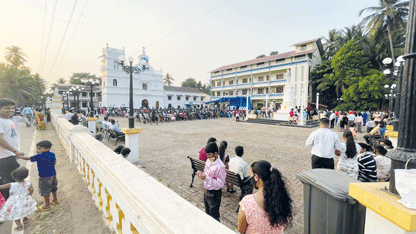Procession of ‘Ordem Terceira’ or ‘Santanchem Pursanv’ are the many names for the procession of saints which takes place in the village of Goa Velha. Goa Velha, formerly known as ‘Govapuri’, was a prosperous village. When the Franciscans Order made its way to the village, in the 17th century, during the colonial rule, they realized the need to instill a sense of penance and prayer in the minds of the local people, due to which, they started the penitential procession of saints. Above is the St Andrews Church parish.
GOA is a state with a number of traditions and customs. The large number of devout Catholics add to the mystique and traditions unique to each village. One such tradition that happens universally at just one place is the “Santachem Pursanv” (Procession of Saints). This unique procession takes place every year at the St Andrew’s Church in Goa Velha. This year’s procession took place after a gap of two years as the procession had to be postponed due to the Covid-19 pandemic and lockdowns….
By Joshua George
THE Santachem Pursanv is an auspicious day and takes me back to rich memories of my childhood. The grandeur of this day thumped even Easter celebrations. Although not a feast it used to be celebrated with great pomp and merriment in my mother’s house nestled between fields and coconut trees in the village of Goa Velha. My grandfather Isias Fernandes enjoyed celebrations be they birthdays, anniversaries, feats, etc.
Santachem Pursanv happens on the Monday before Palm Sunday or Passion Sunday (5th Sunday of Lent) which is the beginning of Holy Week. This is a tradition that dates back to the 17th century. When the tradition began, a total of 65 life-sized richly decorated statues of saints, martyrs, kings, and queens were carried in palanquins on the shoulders of native Christians. Unfortunately, only 31 statues remained until the end of the 19th century.
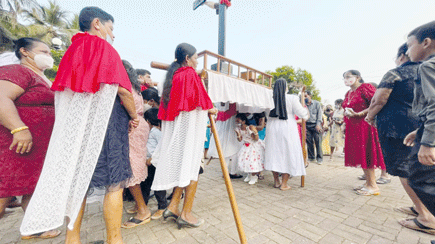
In the old days Goa was witness to a host of processions. Every village feast was accompanied by a procession. Some of these were called the “Corpus Christi’ procession which was held on the first Thursday after Low Sunday (Sunday following Easter), the procession of the Rosary by the Dominican Fathers, the procession of the flagellants (re-enactment of the Crucifixion of Christ) and that of the “bones of the Hanges” by the Confraternity of Charity.
Most of these traditional processions slowly vanished or were wound up for various reasons. This is precisely why I find it fascinating that the Santachem Pursanv still manages to draw revellers from all over Goa. As a kid, the tradition and solemnity of this day wasn’t the thing that I looked forward to. I looked forward to the fair that would come to the village.
Every year my grandfather, grandaunt and granduncle would each give me and my brother Rs100 to spend at the fair. In total the Rs300 made me feel rich enough to be able to enjoy all the highlights of the fair. I recall the St Vincent de Paul (church organisation) stall that my grand aunt would curate along with other members of the confraria(church community). It was the place I would get free snacks and ice-cream to my heart’s content.
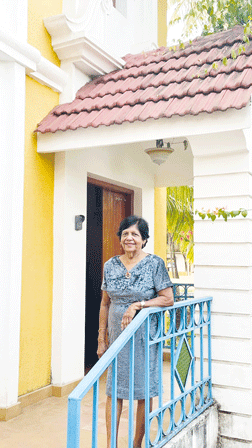
PROCESSION DETAILS
SANTACHEM Pursanv begins with a Eucharistic celebration at the Church square just in front of St Andrew’s High School in Goa Velha. The mass is traditionally celebrated by the parish priest and a host of co-celebrants. This year’s procession was solemnised by Fr Emidio Pinto, the parish priest of the Goa Velha parish.
After mass was over the life size statues of the saints slowly emerge one by one out of the main door of the church. After completing a full circle around the church square the procession then moves down a traditional path towards Goa Velha market — where devotees from all over Goa queue up to offer their prayers. Some devotees walk under each tableau while some walk under the palanquins in which the saints are carried, praying for special favours.
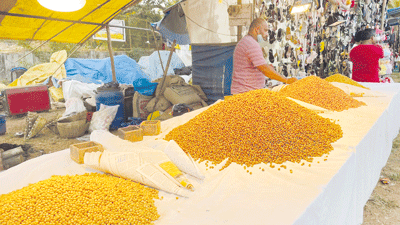
In recent years a notable feature of the procession has been the participation of women as pallbearers, something which is traditionally shouldered by men. Large scale migration has forced the local church to relax the rules to allow women to help keep the tradition alive!
Traditionally, the procession has always followed an order with the first tableau being the Franciscan Coat of Arms which is followed by the remaining 30 saints shouldered by the confraria (member of the church). As the procession makes its way devotees pray the holy rosary and hymns are sung between each decade.
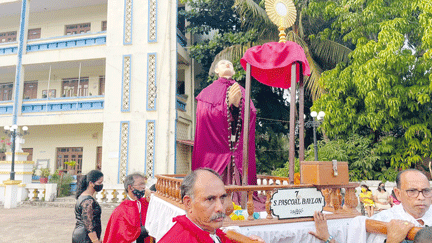
After the procession crosses the Goa Velha market it takes a left turn onto the old national highway and proceeds for a kilometre, before taking another left to the Goa Velha-Batim road. A little ahead it takes another left to the bandh facing the church in a distance. Then gradually it makes its way back to the church compound. The procession begins before sunset and by the time it completes its annual village march it turns dusk.
Throughout the entire walk locals comprising of all faiths may be seen venerating and seeking blessings of the procession of saints. Indeed, the procession is symbolic of the communal harmony that existed in Goa since liberation from the Portuguese. Although not traditionally a feast every Catholic household in the village celebrates the Santachem Pursanv with a grand feast that includes the tastiest of Goan dishes like sorpatel, pork vindaloo, beef roast, etc.
The day would be incomplete without niro or neero (cashew or caju juice or nectar) extracted fresh annually by the tenants who took care of my grandfather’s property on the Batim hill in a neighbouring village. As mentioned earlier the highlight of the day was going to the fair and this was done after the grand feast where the entire family would spend some quality and relaxed time after days of preparation.
I was away in Bangalore for six years and with the covid pandemics and stoppage of the procession for two years, I found myself pleased to cover it this year as a journalist. The entire experience took me back to the good old days of growing up in my mother’s village of Goa Velha and churned up so many good memories!
